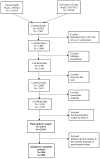Maternal One-Carbon Nutrient Intake and Risk of Being Overweight or Obese in Their Offspring-A Transgenerational Prospective Cohort Study
- PMID: 38674900
- PMCID: PMC11054902
- DOI: 10.3390/nu16081210
Maternal One-Carbon Nutrient Intake and Risk of Being Overweight or Obese in Their Offspring-A Transgenerational Prospective Cohort Study
Abstract
We aimed to investigate the associations between maternal intake of folate, vitamin B12, B6, B2, methionine, choline, phosphatidylcholine and betaine during the period surrounding pregnancy and offspring weight outcomes from birth to early adulthood. These associations were examined among 2454 mother-child pairs from the Nurses' Health Study II and Growing Up Today Study. Maternal energy-adjusted nutrient intakes were derived from food frequency questionnaires. Birth weight, body size at age 5 and repeated BMI measurements were considered. Overweight/obesity was defined according to the International Obesity Task Force (<18 years) and World Health Organization guidelines (18+ years). Among other estimands, we report relative risks (RRs) for offspring ever being overweight with corresponding 95% confidence intervals across quintiles of dietary factors, with the lowest quintile as the reference. In multivariate-adjusted models, higher maternal intakes of phosphatidylcholine were associated with a higher risk of offspring ever being overweight (RRQ5vsQ1 = 1.16 [1.01-1.33] p-trend: 0.003). The association was stronger among offspring born to mothers with high red meat intake (high red meat RRQ5vsQ1 = 1.50 [1.14-1.98], p-trend: 0.001; low red meat RRQ5vsQ1 = 1.05 [0.87-1.27], p-trend: 0.46; p-interaction = 0.13). Future studies confirming the association between a higher maternal phosphatidylcholine intake during pregnancy and offspring risk of being overweight or obese are needed.
Keywords: childhood overweight; choline; maternal diet; perinatal programming; phosphatidylcholine; pregnancy diet.
Conflict of interest statement
The authors declare no conflicts of interest.
Figures
Similar articles
-
Late-pregnancy dysglycemia in obese pregnancies after negative testing for gestational diabetes and risk of future childhood overweight: An interim analysis from a longitudinal mother-child cohort study.PLoS Med. 2018 Oct 29;15(10):e1002681. doi: 10.1371/journal.pmed.1002681. eCollection 2018 Oct. PLoS Med. 2018. PMID: 30372451 Free PMC article.
-
Maternal healthful dietary patterns during peripregnancy and long-term overweight risk in their offspring.Eur J Epidemiol. 2020 Mar;35(3):283-293. doi: 10.1007/s10654-020-00621-8. Epub 2020 Mar 17. Eur J Epidemiol. 2020. PMID: 32185575 Free PMC article.
-
Maternal consumption of ultra-processed foods and subsequent risk of offspring overweight or obesity: results from three prospective cohort studies.BMJ. 2022 Oct 5;379:e071767. doi: 10.1136/bmj-2022-071767. BMJ. 2022. PMID: 36198411 Free PMC article.
-
Offspring body size and metabolic profile - effects of lifestyle intervention in obese pregnant women.Dan Med J. 2014 Jul;61(7):B4893. Dan Med J. 2014. PMID: 25123127 Review.
-
Nutrition in pregnancy and early childhood and associations with obesity in developing countries.Matern Child Nutr. 2013 Jan;9 Suppl 1(Suppl 1):105-19. doi: 10.1111/mcn.12010. Matern Child Nutr. 2013. PMID: 23167588 Free PMC article. Review.
References
-
- Hales C.M., Carroll M.D., Fryar C.D., Ogden C.L. Prevalence of Obesity Among Adults and Youth: United States, 2015–2016. National Center for Health Statistics; Hyattsville, MD, USA: 2017. pp. 1–8. NCHS Data Brief. - PubMed
MeSH terms
Substances
Grants and funding
LinkOut - more resources
Full Text Sources
Medical


